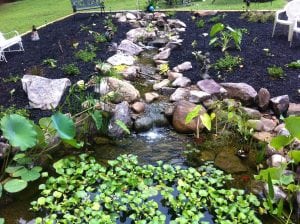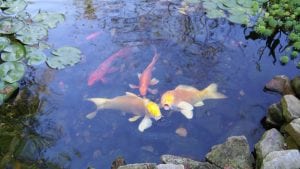
Koi ponds make beautiful additions to your home’s exterior aesthetic. As with any living thing, they require a certain amount of knowledge and understanding in order to care for them properly. Koi ponds require extra maintenance during winter months, even down here in the South. Maintaining water quality and oxygen levels and adjusting their diet are essential when caring for your koi in the winter.
Maintain Water Quality
Appropriate water quality is essential for any type of aquatic environment no matter what time of the year it is. During colder winter months, certain features like waterfalls and filtration systems are inactivated. This means that you need to adjust other factors that affect water quality like the oxygen levels in the water and your koi’s diet.
Maintain Underwater Oxygen Levels
We all know how unpredictable Georgia’s weather can be, going from a blissful 70 degrees one day to a frigid 40 degrees the following night. Since Georgia’s temperatures can drop below freezing, you will need to take extra precautions to maintain high oxygen levels in the water. Water that freezes over for only a few days may not pose a serious threat, but surface water that remains frozen for extended periods of time can create a toxic underwater environment for your koi. Carbon dioxide and other harmful gasses build up underneath the surface, which can lead to the death of your koi population.
In order to prevent this tragedy, install an aeration pump or a de-icer in your pond. Aeration pumps agitate the water’s surface in order to prevent it from freezing over. De-icers heat the pool’s surface to create a continuous hole in the ice. Both of these methods promote a continuous exchange of gases all winter long, even through prolonged periods of freezing.
Adjust Your Koi’s Diet
 Fish digest foods at different rates based on the temperature of the surrounding water. During spring and summer months when water temperature is high, your koi’s digestive system works quickly to absorb nutrients. This means that during these seasons, your koi need frequent meals that are high in protein.
Fish digest foods at different rates based on the temperature of the surrounding water. During spring and summer months when water temperature is high, your koi’s digestive system works quickly to absorb nutrients. This means that during these seasons, your koi need frequent meals that are high in protein.
During the cooler fall and winter months, however, your koi’s digestive system slows down to the point where they are unable to process food. Once the water temperature drops to around 60 degrees Fahrenheit, begin feeding your koi a cool water food that is easier for them to digest. Additionally, reduce their food intake until the water drops to 40 degrees. At this point, stop feeding your koi entirely until the water begins to warm up again in the spring.
You might have concerns about not feeding your koi for a few months, but the fat stored in their bodies from their high-protein summer food will sustain them throughout the winter months. Also, their digestive systems will not begin working properly again until the water is consistently above 40 degrees. So, any uneaten or undigested food will contaminate the pool and potentially harm your koi.
Universal Aquatics Cares About Your Koi Too
Caring for your koi in the winter takes dedication and can be a nerve-wracking endeavor at times. Here at Universal Aquatics, we understand your concerns and your desire to keep your koi happy and healthy all year long. Contact us if you need assistance with your koi pond, or if you think it’s time you are ready for us to install one for you. With over 15 years of experience, we’re happy to service anyone in the Atlanta region for all your backyard aquatic needs.
